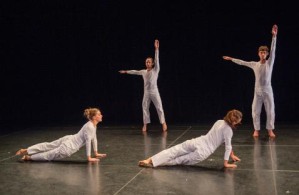
Certainly for everyone with interest in performance art ‘The man walking down the side of a building’ was an early subject of study. And who would have not known Mangolte’s iconic image of ‘Roof Piece’, which seemed to capture the whole spirit of gritty New York City’s 70’s legendary art scene. Gestures travelling through space, across far distances, as the performers tried to decipher from one another across downtown rooftops. It captured not only glimpses of the cityscape, but as well main features of Trisha Brown’s interest. Today this period seems so out of reach in its unique grainy experimentalism, though already at the height of the 80s postmodern theory these times were history, naming Brown and some others of her time mainly from the scene around Judson Church the founders of postmodern dance. 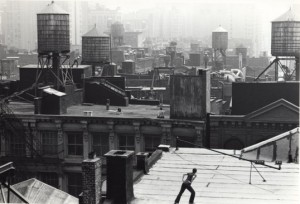
Not just literally that evening of the company’s last Berlin performances, but more so in finally puzzling together major aspects that can be traced throughout Trisha Brown’s work, I came in late. In the small show accompanying the tour’s stop at the Akademie der Künste Berlin I see ‘Water Motor’ as a video again. And then heading home after the performances I find ‘Accumulation of Talking and Water Motor’ online. Especially due to my current interest this early exploration into the relationship between movement and thought is a thrilling pleasure. My experience in ‘understanding’ or reading dance simply grew out of fascination from an intuitive pleasure in watching movement. Noticeably it had to be a movement of certain qualities, like these in Trisha Brown’s work, qualities of energy, lightness, unusual moves, openings, blending over the mind merging directly into the body’s kinesthetic sense of the spectator. A speaking to and from motion that seemed to transmit a specific sort of intelligence, something beyond the explicable, creating a fascination not just built on perfection. 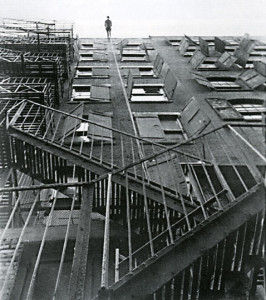
It would not be appropriate to interpret missing perfection into the work of Trisha Brown. Rather perfection here comes as an understatement, a playful lightness, and poetic precision that veils both – mind blowing accuracy and an almost untraceable complexity. The 1981 piece ‘Son of Gone Fishin’ for example seems to be pretty structured, and according to the info sheet it follows the texture of a cut through a tree ‘ABC – center – CBA’. But I simply cannot decipher the logic of why and when some dancers fall in sync with another for two steps and a second later out again. And not to forget – sure it is an 80s reconstruction – that the entire piece is danced in glittery, but baggy costumes, which certainly adds another level of understatement, humor, insight, and intelligence, one that comes in light footed as gaily and elated as can be. Dancing that directly is pointing at your mind/body – body/mind connection.
… [T.Brown] gave an improvisation exercise to use your body as if it is a piece of paper, to fold and crumple and do all the things you can do with paper. And I remember that one of the students asked, “what do you do with your head?†And she said, “you don’t have a head, you’re a piece of paper.†Obviously! (Diane Madden in an Interview with Meg Weeks)
These dancers just do what they need to do – so much is clear. Inverse the movement, join the line, leave the line, reverse – ‘Solo Olos’. A fine game almost like playing tag, which demands single dancers to react, change, reverse or to reverse reverse on command given by one of them, who took a seat in the first row of the audience.
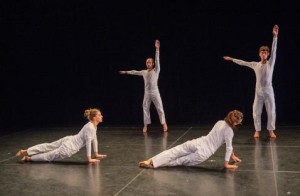
The next piece ‘Rogues’ confronts you with the difficulty to figure out if the dancers were meant to be in sync or not. Was this one step left out on purpose or a mishap? In the end it is almost disappointing when they find into rhythm for a longer time, because it were these tiny broken or missed moves and gestures which created an irritation that made it interesting to watch.
But instant reward followed when the colors started to dance in ‘Present Tense’. Dressed in splendid red two dancers started with a mirrored part, and soon were joined by a blue and yellow dressed young lady supposedly to be more up elevated than having her feet touching the ground. More dancers in red or blue and yellow combinations were dropping in and again it becomes hard to decipher why and when yellow mixes with red, and the next time not. Beautiful though the movements, the flying ambitions of the performers, the support of those who are lifting them. Keep in contact – let them stay in the air and not touch the ground again. Poetic lightness instead of heavy jumps and throws – playful invention rather than arty arrangement.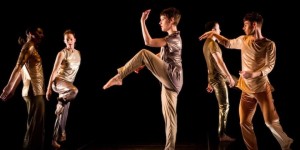
With some names one does forget to think about the possibility that they might not be around anymore. And now I sneaked in just before the door might finally close, as the tour of The Trisha Brown Company will stop by the end of the year, as due to Brown’s health condition no further repertoire will be generated. At least it allowed me to get a glimpse of these exquisite dance works and be confronted with their amazing qualities: a soft, precise, strong and quick, broken, continued, stopped and reversed, unusually mixed and translated flow and rupture of body gestures. Indecipherable in its choreography that does not look like one – in fact more like a play, full of humor and giving room to this libertine feeling democratic dance evokes.
Well, I came in late. I am happy I made it and stayed despite the bad seats and the sort of aged audience that irritated me in the beginning. Trisha Brown’s work is still transpiring a fresh spirit – a leaping lightness conquering my body and mind. Light footed I sneak out before the majority of the crowd crawls out from between the seat rows – red, blue, yellow leaving new combinations of movement on my mind, and imagination of different colors across my body.
other reviews: NY Live Arts
